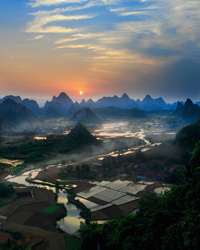Karst Mountains and Caves in Guilin
The Karst Mountains and caves in Guilin are one of the few places on earth that displays the beauty of huge, naturally forged Karst hills and caves. The hills and caves have been an ancient attraction with some inscriptions on its walls dated 729 AD in the Tang Dynasty. The beauty of the place and its imposing structures made this an almost spiritual place to visit and experience. Today, thousands of people visit the site each year and attracting thousands more as the news of its beauty is being spread all over the world.
How the Karst hills and caves came to be?
 The Karst topography in Guilin is one of the largest in the world and thanks to the receding water from hundreds of millions of years ago, the gulf in Guilin bared hills made from limestone and dolomite rocks. As the hills protruded in the newly revealed landscape, rain, wind, and countless rivers develop the unique contours of the hills and the magnificent structures in the caves. All of these took 70 million years for nature to pull off. As acidic water slowly eats the bedrock by flowing to the fractures on the ground, these cracks became wider and allow more water to pass through them accelerating the formation of underground drainage creating caves and underground rivers. The Guilin Karst landscape is a classic example of large scale bedrock dissolution process, dissolving more bedrock than it eventually left out. This made the towering Karst hills possible.
The Karst topography in Guilin is one of the largest in the world and thanks to the receding water from hundreds of millions of years ago, the gulf in Guilin bared hills made from limestone and dolomite rocks. As the hills protruded in the newly revealed landscape, rain, wind, and countless rivers develop the unique contours of the hills and the magnificent structures in the caves. All of these took 70 million years for nature to pull off. As acidic water slowly eats the bedrock by flowing to the fractures on the ground, these cracks became wider and allow more water to pass through them accelerating the formation of underground drainage creating caves and underground rivers. The Guilin Karst landscape is a classic example of large scale bedrock dissolution process, dissolving more bedrock than it eventually left out. This made the towering Karst hills possible.
In fact the sharp, slender slopes made the Guilin site very unique from other Karst landscapes of the world. This explains the extensive underground structures – a lot of water was channeled from the hills to the ground creating enormous cave complexes. The scale of the hills and the huge number of interconnected caves and rivers made this area a wonderful place to just be amazed of the natural sites on your every turn.
Elephant Trunk Hill
The Elephant Trunk Hill sits where the Li River and the TaohuajiangRiver meet. The height of this rock structure is 55 meters and has a curious form, like an elephant drinking in the river, thus its name. The trunk of the “elephant” is formed through a perfectly created cave that goes through and through the whole rock formation. There are many ways to enjoy this Karst hills site – you can get on top of it and have a panoramic view of the Li river and Guilin city, or go through the main cave and just bask in the waterfront sceneries that is teeming with an elephant theme. With the many statues around the hill you can have a thousand places to take photos with the family.
Fubo Hill
The Fubo Hill is located on the western side of the Li River. Because the waves from the river is effectively blocked by its structure (it stands halfway on the river and on land), it is believed that the rock structure is a wave-subduing hill. The structure is enhanced by natural terraces and artificial pavilions, with many trees and plants thriving on its steep slopes. With its elevation at 213 meters it is a structure that can be very hard to miss on the landscape. On this hill a commemorative temple for Gen. Fubo was also constructed making it a historic site as well as a natural wonder for you to enjoy.
Nine Horse Fresco Hill
This land structure is just 40 km away from Guilin. The best way to enjoy this hill is to cruise the Li River from Guilin towards Yangshuo. What makes it popular to the locals and tourists alike is the face of the hill which has images of horses in a variety of positions. A good challenge will be to identify the nine horses in the hill face while you cruise parallel to it. Because you only have 3 minutes of ideal viewing angle of the hill, this can be a very engaging experience for everybody in the cruise.
Scenery on 20 Yuan Bank Note (Yellow Cloth Shadow)
If you are in a Li River cruise you can surely enjoy the scenery you see in a 20 Yuan bank note. This spot is halfway through Xingpin and Yucun. As the cruise makes a big turn toward Xingpin the scene will reveal itself with the beautiful tri-peak Karst hills up ahead and the other distant hills on the background. It will also highlight the reflective water and the green scenery of the valleys by the river. This scenery is topped off with fishermen floating in their bamboo rafts. Many tourists see this scene as an accurate image of Chinese landscape – a combination of mountain and water that complement each other flawlessly.
Reed Flute Cave
This cave is named after the reeds that grow around its vicinity which is commonly used to make flutes. The 240 meter long cave boasts magnificent pillars, stalactite formations, and other rock formations. Today the cave is illuminated by colored lights highlighting its underground beauty. The cave is conveniently located just 5 kilometers from Guilin. The cave is best enjoyed by listening intently to the stories behind the formations inside the cave. Each spot is named interestingly, poetically, enhancing the experience of the cave tour. The tour takes a U-shaped route that is wrapped up within an hour. If you have a camera you might need special equipment with you to have the right exposure inside the cave.
Seven Star Cave
The seven star cave is a 1000-meter cave that has magnificent rock structures inside it. On some places its ceiling reaches 27 meters. Its name is derived from the stars of the big dipper constellation. It was in the Tang dynasty that the cave complex was discovered. Like the other caves in the Guilin area, the structures in the cave are artificially lighted to bring about the beauty of the formations. In World War II, the cave was used by the locals as a shelter. It has a year round temperature of 20 degrees Celsius which made it an ideal hiding place for many refugees of the war. The tour inside the cave can take up to an hour, not bad at all for an adventure-hungry tourist like you.
Crown Cave
The crown cave is the most popular cave in Guilin. Its name is derived from the hill on top of it which shaped like a crown. It is also called the Guanyan Cave, boasting an extensive number of rock formations along its 12 km length. The cave is just 28 kilometers away from Guilin making it one of the most visited caves in the area. The journey to the cave is already an adventure with light rail and elevators part of the whole tour. Inside you can see stalagmite and stalactite formations that are both huge and beautiful. It even has a palm-shaped rock formation (palm hall) that reaches a height of 50 meters towards the ceiling of the cave. You can then explore the length of the cave by boat and at the end of that boat ride you can see the Guilin Karst landscape. This can be the best way to end the whole underground excursion. Never miss the crown cave in your next trip to China!
Got questions? Ask us here!
Sally Guo
Travel Advisor
